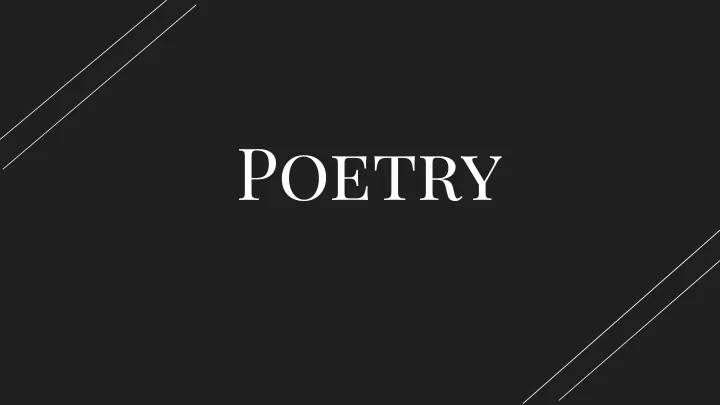

Poetry
What is poetry? Poetry is a type of literature in which the ideas or emotions expressed in the piece are expressed in some sort of form, usually with line breaks, rhythm, meter, and/ or rhyme.
Important aspects of poetry Structure Meaning Structure Structure S o u n d Structure
Sound When thinking about the sound of a poem, it is important to consider the sounds of the words in it and how they fit together. There are a few important terms to know to analyze this in poems and to be mindful of the sounds of your own poems. Alliteration > Repetition of consonant sounds, particularly those at the beginning of words Assonance > Repetition of vowel sounds. Caesura > A deliberate rhetorical, grammatical, or rhythmic pause Consonance > Repetition of consonant sounds anywhere within the words. Meter > The rhythmic measure of a line. Rhyme. Words with similar sounds (write/ sight) Rhythm. The beat and movement of language - the pattern of stressed and unstressed syllables
Meter English poetry employs five basic meters, including: 1.Iambic meter (unstressed/stressed) 2. Trochaic meter (stressed/unstressed) 3. Spondaic meter, (stressed/stressed) 4. Anapestic meter (unstressed/unstressed/ stressed) 5. Dactylic meter (stressed/unstressed/unstressed)
Exercise: Write a line or two with a meter of your choice. 1. Iambic meter (unstressed/stressed) 2. Trochaic meter (stressed/unstressed) 3. Spondaic meter, (stressed/stressed) 4. Anapestic meter (unstressed/unstressed/ stressed) 5. Dactylic meter (stressed/unstressed/unstressed) or Write a line or two with another sound technique like rhyme or alliteration.
Structure When thinking about the structure of a poem, there are many things to consider. The first is form - which form works best for what the poem is saying?
A few examples of form: Haiku A poem with a three-line stanza or stanzas composed of a 5/7/5 syllable count Example: In the twilight rain these brilliant-hued hibiscus - A lovely sunset. Matsuo Basho
A few examples of form: Sonnets A fourteen-line poem written in iambic pentameter. Let me not to the marriage of true minds The New Colossus Admit impediments. Love is not love Not like the brazen giant of Greek fame, Which alters when it alteration finds, With conquering limbs astride from land to land; Or bends with the remover to remove. Here at our sea-washed, sunset gates shall stand O no! it is an ever-fixed mark A mighty woman with a torch, whose flame That looks on tempests and is never shaken; Is the imprisoned lightning, and her name It is the star to every wand'ring bark, Mother of Exiles. From her beacon-hand Whose worth's unknown, although his height be Glows world-wide welcome; her mild eyes command taken. The air-bridged harbor that twin cities frame. Love's not Time's fool, though rosy lips and ‘Keep, ancient lands, your storied pomp!’ cries she cheeks With silent lips. ‘Give me your tired, your poor, Within his bending sickle's compass come; Your huddled masses yearning to breathe free, Love alters not with his brief hours and weeks, The wretched refuse of your teeming shore. But bears it out even to the edge of doom. Send these, the homeless, tempest-tost to me, If this be error and upon me prov'd, I lift my lamp beside the golden door!’ I never writ, nor no man ever lov'd. -Emma Lazarus, adorns the Statue of Liberty Shakespeare, Sonnet 116
Celestial Dreams A few examples of form: Pantoum Moonbeams creamy as pie Racing across the night On a journey into the sky A pantoum is a Malaysian poetic form Dreams seeking celestial light Racing across the night composed of four-line stanzas with an Past Venus waking from sleep Dreams seeking celestial light Cast into the dark so deep AB/AB rhyme scheme. Lines 2 and 4 of Past Venus waking from sleep the former stanza form lines 1 and 3 of To Saturn's expanding rings Cast into the dark so deep Catching a ride on angel's wings the next stanza. To Saturn's expanding rings On a journey into the sky Catching a ride on angel's wings Moonbeams creamy as pie Marie Summers
There are hundreds of forms! https://www.writersdigest.com/whats- new/list-of-50-poetic-forms-for-poets There are also other poetic forms like found poetry and black-out poetry that fit into the concept of form as well and are really fun to play with if you’re struggling! Found poetry is when you assemble lines from already existing works. In black-out poetry, you black out words on an existing page to create a poem.
Choose one option below and write for five minutes. 1. Write one of the examples of poetic form already discussed! A Haiku: A poem with a three-line stanza or stanzas composed of a 5/7/5 a. syllable count A Sonnet: A fourteen-line poem written in iambic pentameter. b. A Pantoum: Four-line stanzas with an AB/AB rhyme scheme. Lines 2 and c. 4 of the former stanza form lines 1 and 3 of the next stanza. 2. Write an ode or an epitaph. An ode is a poem of praise. An epitaph is a poem that would go on someone’s tomb. 3. Choose your own form and write!
Meaning However you construct your poem, be sure to be consistent with the meaning of the poem. Choose form and the sounds of your poem to be consistent with your meaning. Choose images and words that are consistent with your meaning. You don’t want the reader to be taken out of the poem and confused because of inconsistencies with general meaning or energy.
Final exercise Write three similes and find some way to weave them together into a poem with one meaning. or Choose a line from one of your favorite songs and write a poem using it, but the poem must have a very difgerent meaning from the song.
Recommend
More recommend